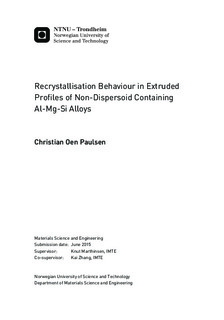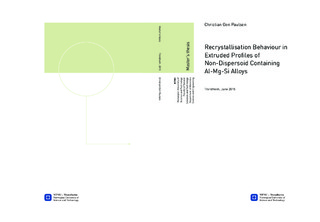| dc.description.abstract | Hot extrusion of non-dispersoid containing aluminium alloys commonly ends with a fully or partially recrystallised grain structure. However, the recrystallisation mechanisms, whether static or dynamic (taking place during deformation) are still not clarified. This report investigates extruded axisymmetric Al-Mg-Si alloys with respect to evolution in texture and microstructure in a spontaneously recrystallised material (i.e. during extrusion) and in a material which is deformed after extrusion and then recrystallised during subsequent annealing at different temperatures. Comparison between the post-heat treated and spontaneously recrystallised material have been done to characterise and identify differences in the recrystallisation behaviour and possible difference in mechanisms. Some simulations have also been conducted by the softening model ALSOFT to compare the experimental results with the model predictions.
The spontaneously recrystallised material showed a texture which differed from the material which recrystallised during post-extrusion heat treatment. This demonstrates a difference in recrystallisation behaviour and possibly the nucleation mechanisms. ALSOFT simulations seemed to give reasonable grain size results when comparing them to the experimental results in this project. However, the relative contribution from different nucleation mechanism predicted by ALSOFT did not comply well with experimental data.
The recrystallisation texture software RDB_texture was successfully implemented into Matlab. RDB_texture was created for rolling, therefore, some modifications to the Matlab implementation was made to make it applicable for axisymmetric extruded round bars. Most notably it is possible to choose both orthorhombic and triclinic specimen symmetry. The simulated textures were compared with experimentally found textures in order to identify input parameters giving the best agreement with experimental results.
By simulating recrystallisation texture, a set of weighting factors for different nucleation mechanisms giving the best agreement with statically recrystallised samples was determined. This was when having ~65% cube nucleation, ~30% grain boundary nucleation and some PSN. For spontaneously recrystallised samples, the best agreement was found with mainly 100% cube nucleation as the input value to the software. | |

